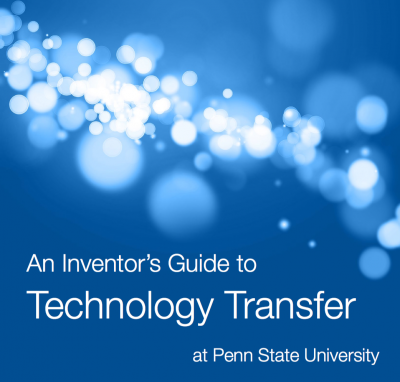Protect Your Invention
Filing an invention disclosure with the Office of Technology Management is the first step in protecting your intellectual property:
The Office of Technology Management promotes Penn State technology by protecting, marketing, and licensing University inventions to companies for further development and commercialization. The OTM reviews the information for patentability and, based on the novelty and utility of your invention, will decide whether or not to file a patent application. To file an invention disclosure, faculty, graduate students, and staff should visit the Technology Disclosure Form and Online Invention Disclosure Portal webpage
What Happens After Submission of the Invention Disclosure?
- A disclosure number will be assigned to the invention and a Technology Licensing Officer will be assigned to work with the inventor and the invention. Assignment usually occurs within 2-3 weeks after submitting the invention disclosure.
- The Technology Licensing Officer contacts the inventor (or principal inventor contact) for an initial discussion.
- The Technology Licensing Officer assesses the invention to determine possible commercial or protection strategies. However, not every invention lends itself to patenting or other protection; the invention may be marketable as know-how or a trade secret. Patentable inventions are unique, non-obvious, and useful in that they fulfill a genuine market need.
- If protection is deemed appropriate, a provisional patent application is generally filed. A provisional patent application is not a full patent application. It provides a one-year period in which to file a full patent application, and it establishes a priority date for the invention. Penn State frequently uses provisional patents to protect inventions that are to be subsequently publicly disclosed as a conference talk or in an academic paper. The inventor will work with a local law firm to draft the provisional patent application.
- The year between the provisional filing and full patent filing is the opportunity for the inventor and the Technology Licensing Officer to further advance the invention by securing additional funding, developing the technology, performing market analyses, searching for similar or identical patents, and/or contacting commercial entities interested in the invention for further commercial development. This one-year window is crucial for positioning the invention for patenting; it should be a collaborative effort between the inventor and the Technology Licensing Officer.
- The University Patent Review Committee reviews the invention disclosure and the provisional patent application for inventions not derived from industry-funded research projects. The committee includes the Assistant Vice President for Research, the Director of the Office of Technology Management, and the Research Deans of the following colleges: Medicine, Engineering, Earth and Mineral Sciences, Agricultural Science, and the Eberly College of Science. The committee provides a pass/fail recommendation for patent protection that strongly influences the decision to file for a patent. If patent protection is deemed appropriate, the Office of Technology Management contracts with outside legal counsel to prepare the appropriate application(s). The inventor should work closely and in a timely manner with legal counsel to ensure that an effective patent application is drafted. Applications/inventions that are not accepted for patenting may be abandoned, revised based on further development of the invention, or in some cases re-assigned to the inventor.
- The Office of Technology Management negotiates to secure an appropriate technology transfer, normally in the form of a License, Option, or, in some cases, Materials Transfer Agreement. The inventor typically has no role in the negotiation process.
-
If a License, Option, or Materials Transfer Agreement is reached, financial returns, after deducting patent expenses, are distributed as follows:
PSRF: 40%
Inventor(s): 40%
Administrative Unit of College: 20% - The inventors' portions of the income are divided according to the contribution percentage that the inventors establish. A memo to establish the percentages to be paid to each invention will be sent to the Inventors before making payment .
Educational Resources
 PSU Inventor's Guide to Technology Transfer
PSU Inventor's Guide to Technology Transfer
 The Basics of Intellectual Property and Technology Transfer (Video)
The Basics of Intellectual Property and Technology Transfer (Video)
This Webcast contains a discussion on how an innovative idea stemming from your research can be translated into a business venture.

